There she was, then, doomed to undergo the vagaries of the brush and a painter’s determinations. In “real” life she was well accompanied. In her painted existence, she strides alone towards us past pews of onlookers absorbed in their own tales, men on her right, ladies on her left. Whether the Metro station was actually behind her I no longer remember although it was surely nearby, its copper green bulges and twists a landmark I had long loved, wishing for an excuse to explore all those intricacies with paint. I like to scatter urban scenes with strategic dogs and bikes, and these, though imported into the composition, were in ample supply where she walked, available to connect the Metro sculpture to its environment. So it was that Bringing Forth moved past an initial unreflecting impulse to preserve and remark toward a wider, more contrived, “conceptualist” work of art, yet still very much a commodity, a thing of paint and cloth, wood and staples, however it may be held together by imagination of assembly and contemplation. The most difficult aspect of its facture was the space ahead of the woman, the “Forth” between her and the bottom of the painting, otherwise known as a “foreground,” and sure to get the scrutiny of Charles Emerson, whose understanding how color shapes space has improved my work.
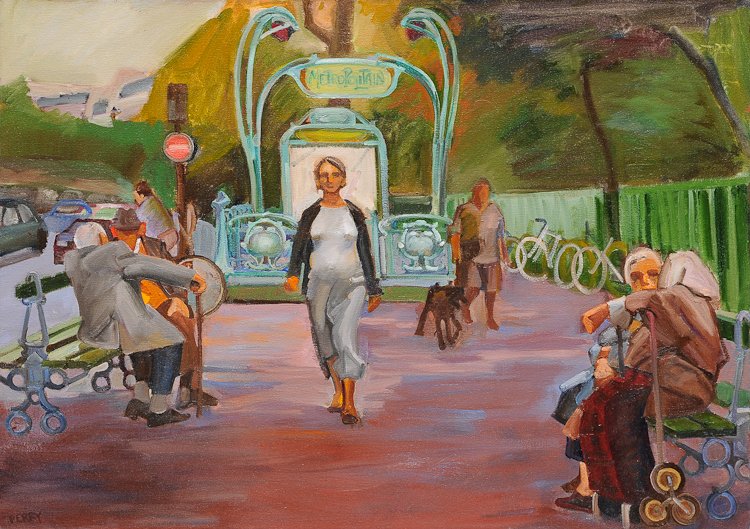 Bringing Forth I, oil on canvas, 20 x 28 inches, copyright ©2005
Bringing Forth I, oil on canvas, 20 x 28 inches, copyright ©2005
Bringing Forth II has an elder sister, a painting I had realized needed two inches of height as well as “more paint” (as another teacher, William Elston. would say). It now resides with a friend who said she wanted it just as it was, and, insisting I stop work immediately, carried it away leaving ransom behind. I prefer #II, the “reproduction,” now hanging in the office of a family member whose job description includes promotion of women’s reproductive health. Do I “name” paintings before I begin them? I can think of no instance when this happened: being precedes essence. These works sometimes acquire an identity during gestation, sometimes only after parturition, and then, as they settle into existence, sometimes acquire nicknames. I can’t remember at what point in this process Bringing Forth became itself.But I anticipate. The Paint Project began in 1990 soon after the move to Seattle and a year spent making a nest there which, it turned out, included a loft that looked very much like an artist’s studio. Somehow these activities had consumed the time and energy I meant to use re-establishing myself as a social worker in an environment 3000 miles west of Boston, where that identity had seemed beyond question. Instead, once the dust was swept away, I carried a large piece of canvas up the spiral stairs and stapled it to a wall. Of a sudden, “real” people, not “clients,” but “images” rather, began to show up, flattened, in two dimensional space. The impetus for The Evil Eye (above) had begun three years earlier when with no apparent plan, riding with my husband in one of the small scooter-based two-passenger vehicles which cluttered New Delhi traffic, I began to take too many pictures. It was 1987 and cameras still used film. Fueling the black box in India required lengthy, expensive commercial negotiations which I’d already endured in large numbers so as to provide photographic models for the many paintings I had been making during that nine month 1986-7 India adventure, pictures of people and animals in the street, living lives alien to any previous understanding of any world I’d ever seen. Reasonably, my husband asked after my sanity. My story was that sometime I wanted to make a single big painting that would capture what I saw and felt as we barreled down the street behind a driver intent on penetrating Delhi’s unruly, perilous traffic. And I had an idea that using the old Olympus camera’s double exposure button might address the problem of representing the space ahead while allowing for the presence of the brave soul taking us into it. No one was more surprised than I was when, around John’s 61st birthday, 4/9/90 (see the license plate lower right hand corner), You With the Evil Eye emerged. Its full title, an inscription lifted from the rear of one of these cabs and inscribed over the driver’s shirt, is You With the Evil Eye May You Also Be Blessed –or so I’ve been told by friends who read Hindi. An alternate title, John’s answer to my question why there were marigolds always and everywhere in India, is “The Gods Prefer Marigolds.”
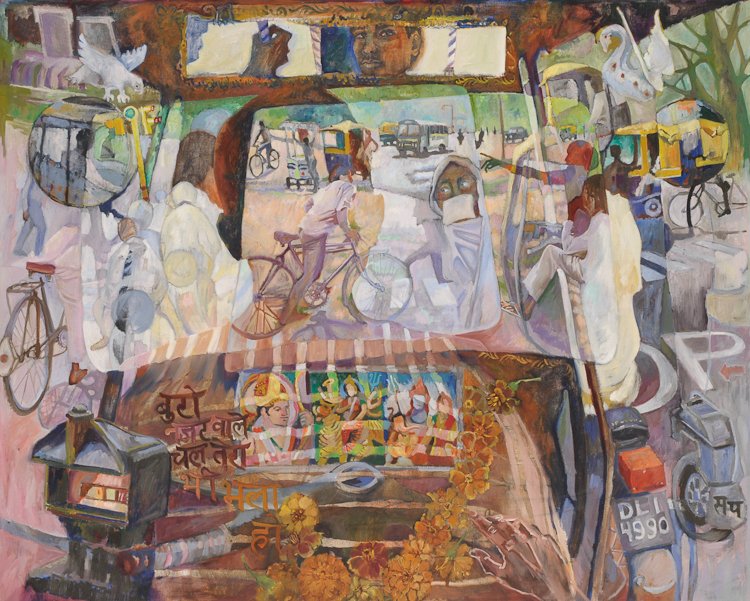 The Gods Prefer Marigolds You With the Evil Eye, oil on canvas, 50 x 62 inches, copyright ©1990
The Gods Prefer Marigolds You With the Evil Eye, oil on canvas, 50 x 62 inches, copyright ©1990
Meanwhile a number of paintings inspired by trips from Seattle to Mexico appeared and were displayed at the University of Washington’s Cunningham Gallery (back in the days when the UW felt it should promote women painters) in 1992. Below, the work featured on the invitation for the show. The old Olympus with its double exposure button continued to suggest ways to depict space at once inhabited and empty and I made extensive use of this in the Cunningham paintings. Oddly enough (remember Bringing Forth, above), this painting is titled “Annunciation.” I had forgotten that until now. The Louvre is littered with paintings of this subject: the Virgin alone in her walled garden, finger holding the place in her book of meditation, when from nowhere appears an angel: “You’re preggers, girl!” For a time, I collected these images.
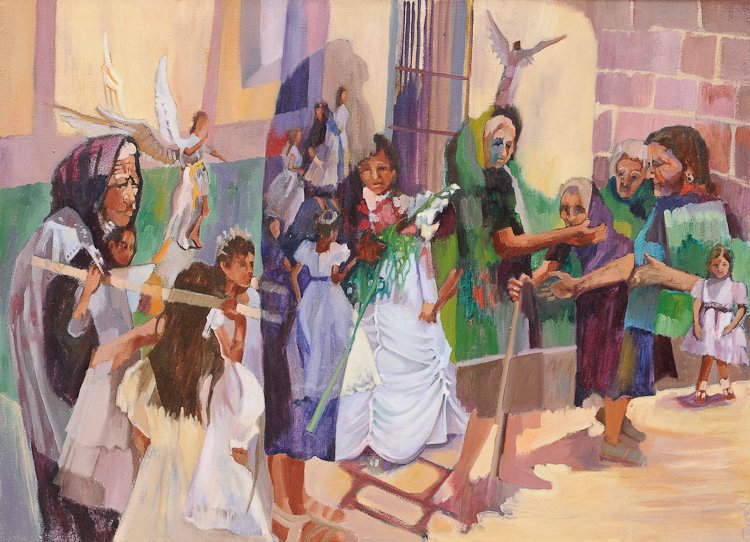 Annunciation, oil on canvas, 26 x 36 inches, copyright ©1992
Annunciation, oil on canvas, 26 x 36 inches, copyright ©1992
Then, in 1996, came support from the King County Arts Commission for a show at the Smith Tower. They liked the India paintings which had been accumulating since 1990. Below, “Passing Her,” the painting chosen for that invitation:
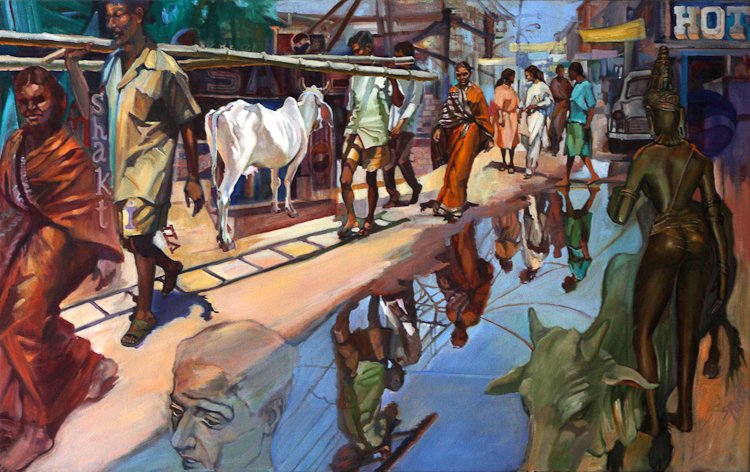 Passing Her, oil on canvas, 30 x 48 inches, copyright ©1995
Passing Her, oil on canvas, 30 x 48 inches, copyright ©1995
Its name was suggested by John Perry, House Poet. Its pronoun can be understood as “woman,” “cow” or goddess,” preferably all three, and its verb refers to the movement implied by the repetition of the central female figure as she moves from background to foreground. The mirroring produced by a long puddle is an element which has appeared increasingly as my work has evolved. The four elements, animals, humans, sculptures & puddles, were in plentiful supply in the India paintings, three of which entered the outsized pair below:
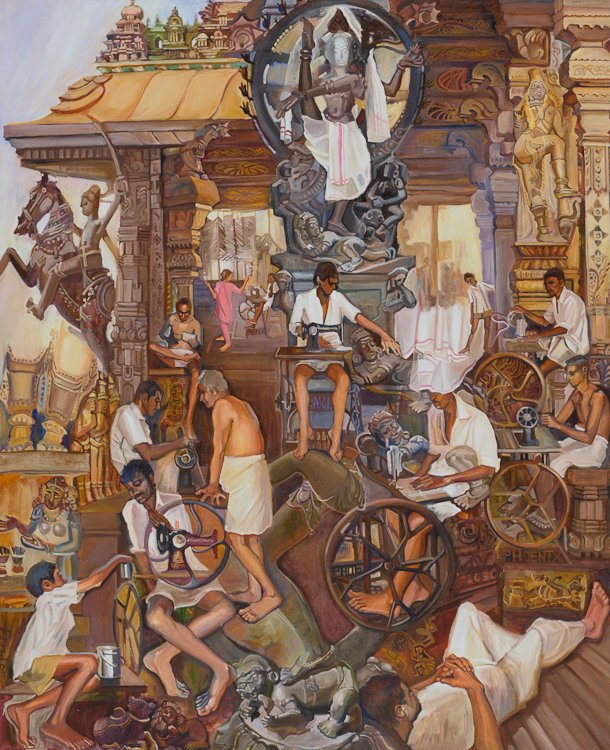 | 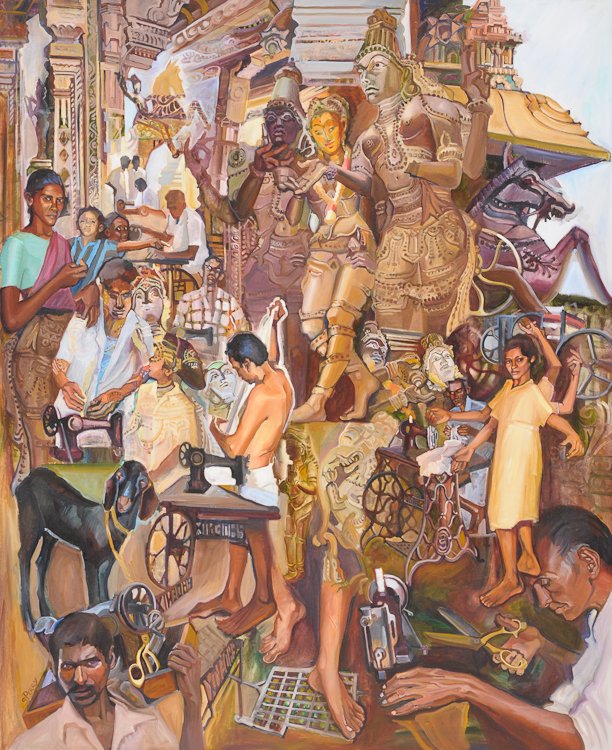 |
| Dancing on the Dog I Dressing the Gods, oil on canvas, 68 x 56 inches, copyright ©1995 | Dancing on the Dog II Menakshi's Wedding, oil on canvas, 68 x 56 inches, copyright ©1995 |
In 1997, I completed a series of “France” paintings, begun as the India adventures and their painted images wound down and we made trips to Provence as well as Paris, where I found the slow-moving game of boules and its environment an excellent opportunity to indulge my interest in painting figures, both human and bovine. (See the “Elsewhere” category in this site for Transhumance Chapeau Vert and Transhumance Vin Rouge.) The mysteries of their surrounding space remained less intriguing: I tended to regard it as ectoplasm, the stuff that held the figures together, rather than an integral part of an entire painting. At that point my attempts at “artist’s statements” referred to “peopled space.” These works were displayed for a time in the Lynnwood Public Library, an exhibit sponsored by the Lynnwood Arts Commission.
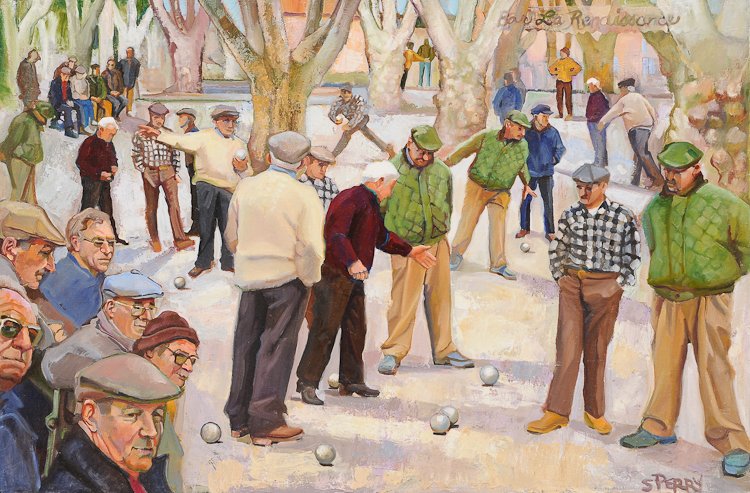 Boules St. Tropez, oil on canvas, 30 x 45 inches, copyright ©1997
Boules St. Tropez, oil on canvas, 30 x 45 inches, copyright ©1997
In response to the House Framer’s laconic, “Too many boules,” I turned away from exotic subjects and focused the next batch of paintings on Seattle. The framer, my carpenter brother John Michael, had a point I’d long tried to avoid: probably realist painters should paint where they live. Maybe there’s a kind of Bad Faith involved in choosing exotic subjects. This new- found honesty went, however, unrewarded: the show which followed in 1999 at the Pine Street Martin Zambito Gallery was a flop. Kindly as its owners were, they had to bow to public sentiment: no more shows. I decided to accept this verdict and interpret it as a license to paint elsewhere, anywhere in fact I wanted to. Below a large painting from the M-Z show: “University Heights II: Find Her,” which features a very young heroine, the only figure in the crowd who looks at the viewer. The painting also includes a pair of reflections at the edges—a device I used again recently to reflect a standing, adult version of that child, this time riding the Paris Metro. The University Heights School Building, which backgrounds “Finding Her,” had been a grade school for our eldest grandchild, and was an important family landmark: when it was shut down, our daughter’s reaction was to run for school board: she wanted to reverse a decision made in favor of financial interests over the needs of school children. At the time of the painting it was being rented out to the Seattle School of Realist Painting—later Gage, an art school that now offers a much wider curriculum and has made its way across the ship canal to Broadway.
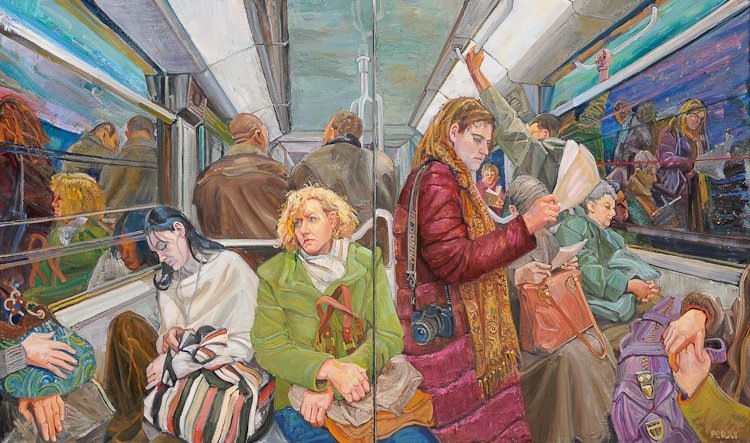 Paris Metro, oil on canvas, 36 x 60 inches, copyright 2012
Paris Metro, oil on canvas, 36 x 60 inches, copyright 2012
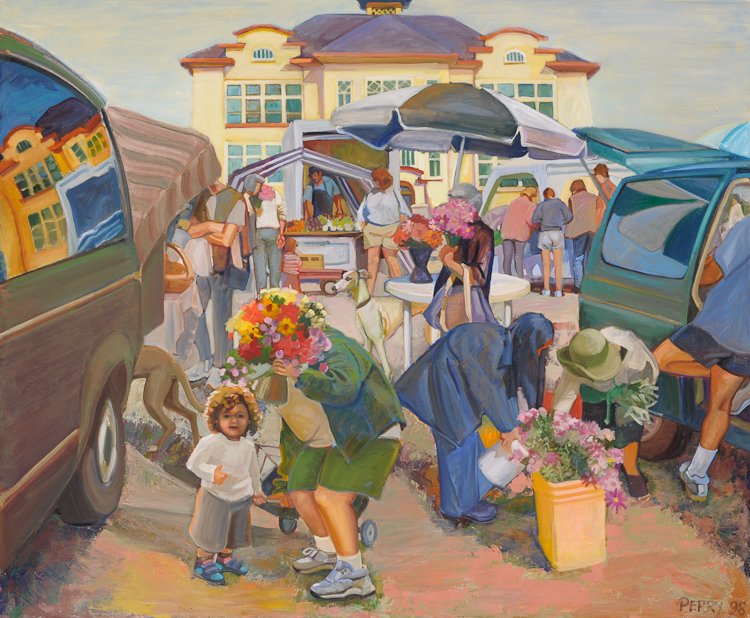 University Heights Market Find Her, oil on canvas, 52 x 62 inches, copyright ©1998
University Heights Market Find Her, oil on canvas, 52 x 62 inches, copyright ©1998
Free to paint anywhere, I decided to take the paints to New York City. For the several years in Binghamton, I’d lived a few hours by bus from NYC. More significantly for me, it was the location of my first summer away from Indiana: I was 20, newly married and pregnant (not necessarily in that order), ready to see the ocean for the first time and check out Picasso’s Guernica, still hanging then in the Museum of Modern Art. It was a brief stay in a sublet on 105th Street, just off Broadway. Unwilling to quit school altogether I took a course in Shakespeare at Hunter College, tilting the scales once more in favor of my ultimate fate as an English major, a destination resumed when my then husband’s job search succeeded and we turned the old Dodge back west for eight years in Ann Arbor. Why English? I believed (wrongly of course!) that I already knew how to read and saw clearly that figuring out how to paint would mean a great many studio hours away from home and family. But in 1998 nostalgia was not the only reason to go to the City: its museums and its proximity to more museums in Boston and the other Washington was reason enough. NYC was full of visual excitement for a painter, and looking at the work of others was part of that. We found space at the Leo House, a Catholic hostel, very different from its neighbor The Chelsea Hotel a block further up 23rd St but more reasonably priced. I selected the closest corner, at 8thAve., for a plein air painting.
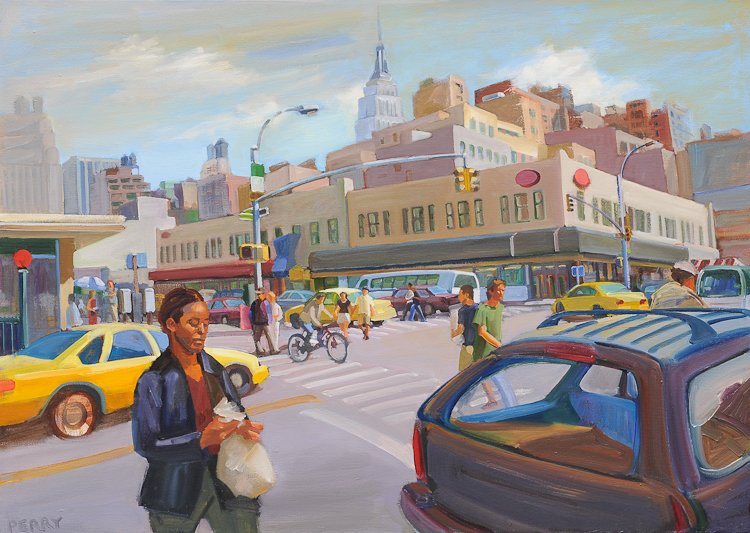 23rd & 8th Avenue, oil on canvas, 20 x 28 inches, copyright ©2002
23rd & 8th Avenue, oil on canvas, 20 x 28 inches, copyright ©2002
And I met fellow artists from Binghamton and Albany in upstate New York (Debbie Chess and Diane Lercher) who generously let me do portraits:
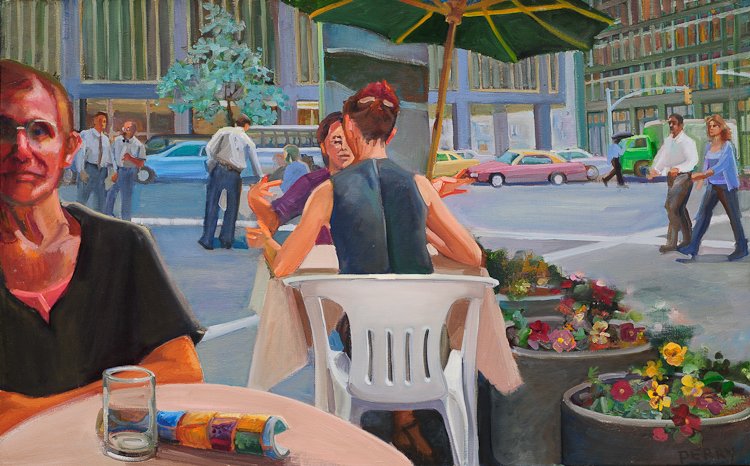 Aprés Bonnard, oil on canvas, 20 x 32 inches, copyright ©2002
Aprés Bonnard, oil on canvas, 20 x 32 inches, copyright ©2002
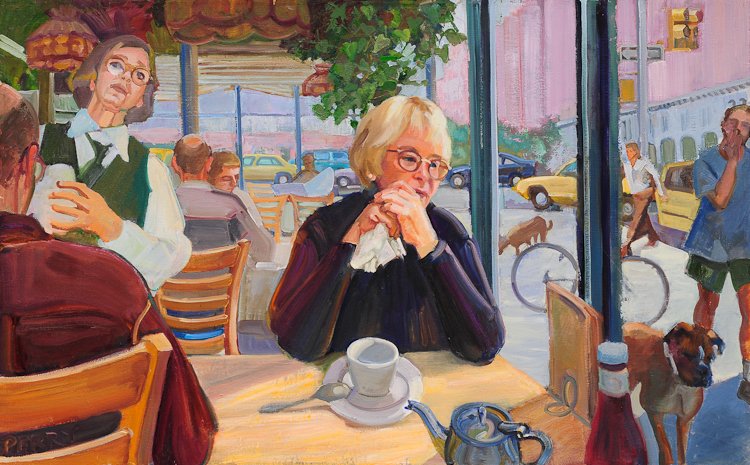 What It Takes, oil on canvas, 20 x 32 inches, copyright ©2002
What It Takes, oil on canvas, 20 x 32 inches, copyright ©2002
Fall 2001, the series was, I thought, complete, and ready to peddle. Surely Seattle was ready for New York. I made the required slides and began the dismal rounds of galleries. This depressing experience was quickly trumped by the fall of the twin towers. January 2002 I decided to go back to New York to look again. By that time the Ground Zero hole was less dramatic than it appeared in the TV reports. I took pictures of lookers and made Ground ZeroViewing.
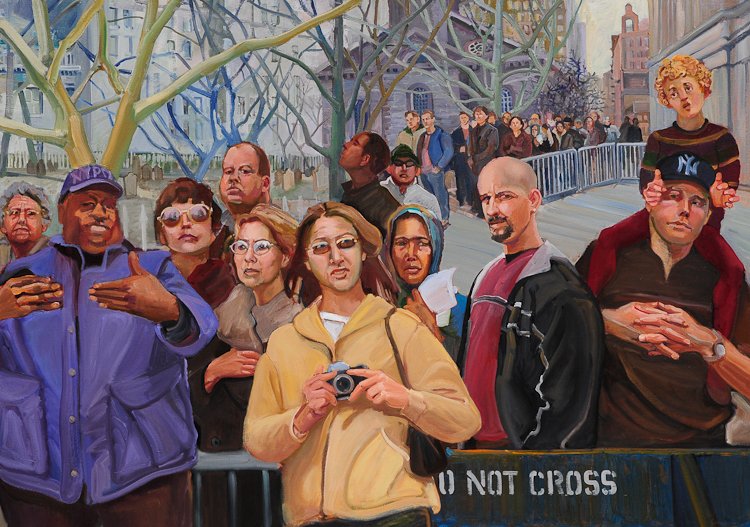 Ground Zero, oil on canvas, 32 x 45 inches, copyright ©2002
Ground Zero, oil on canvas, 32 x 45 inches, copyright ©2002
Why was I not surprised when it turned out Seattle galleries were not ready for even New York-returned Perry paintings? A better, faster learner (or one more dependent on market forces) might have put the paints up for sale on e-Bay, but I was lucky: there was always Paris. Since 1999 we had begun to spend two months of the year in Paris, sometimes more. There were museums, lively streets and places where, for the price of a cup of coffee, a great variety of people could be shanghaied as models..
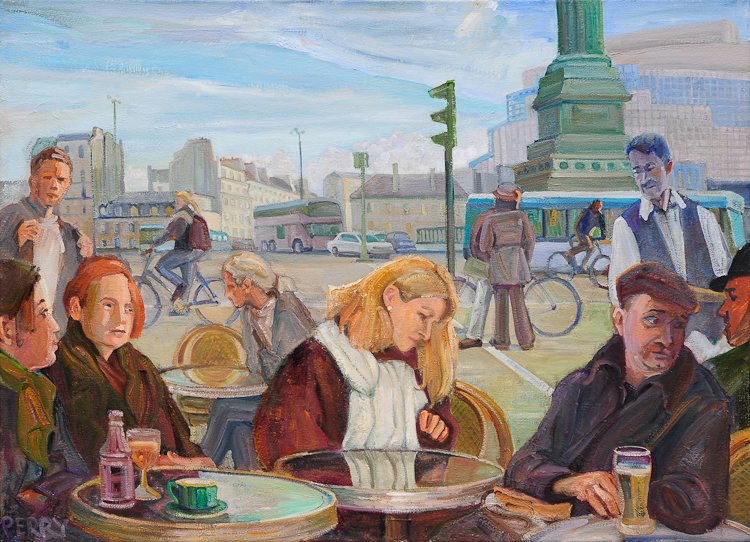 Circulation Bastille: Phares, oil on canvas, 22 x 30 inches, copyright ©2009
Circulation Bastille: Phares, oil on canvas, 22 x 30 inches, copyright ©2009
“Phares Circulation Bastille” (above), began in 2000. The café is a bistro on Place Bastille offering rest after our walk past vegetables & cheese at the open air Sunday market, along the underground canal where Bringing Forth was conceived in 2002. Later, in 2007-9, I painted les Phares again:
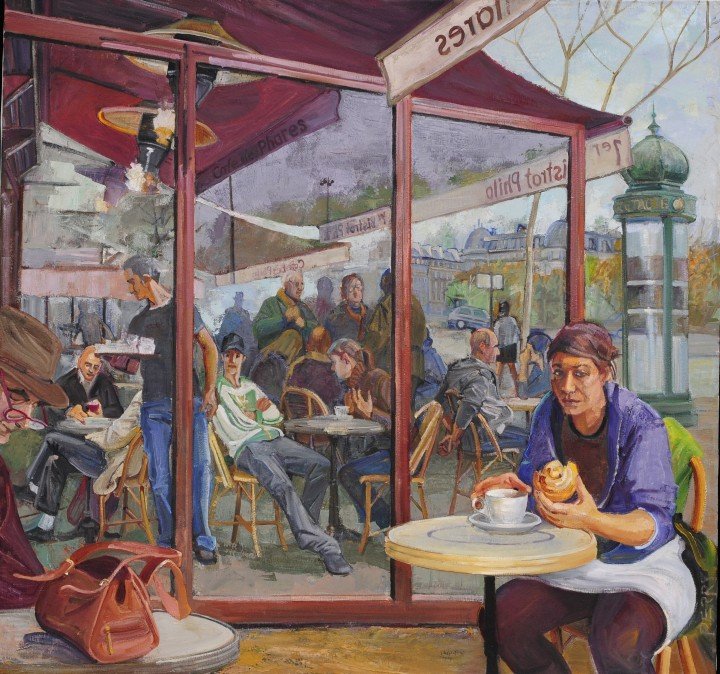 Café des Pharés, oil on canvas, 34 x 36 inches, copyright ©2009
Café des Pharés, oil on canvas, 34 x 36 inches, copyright ©2009
The second attempt reflects greater curiosity about its space. The name of the bistro probably alludes to Baudelaire’s poem celebrating the light cast by European painting from Rubens to Goya and Delacroix. But when brother John Michael framed it, he remarked that the girl ruminating over her Sunday wafer was surely “Trix,” our mother. I had not seen the surprising resemblance.
Other relatives and friends have been more consciously selected:
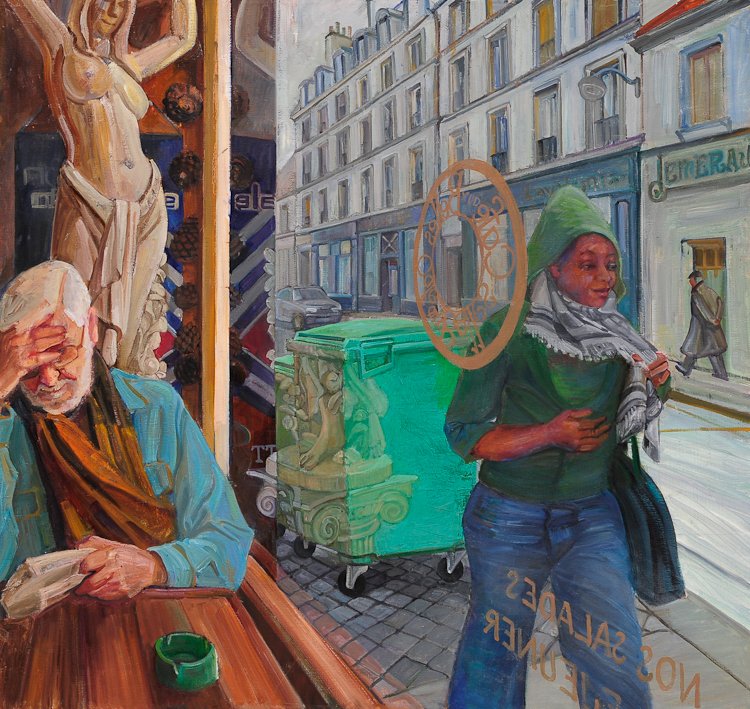 Café aux Belles, oil on canvas, 36 x 38 inches, copyright ©2009
Café aux Belles, oil on canvas, 36 x 38 inches, copyright ©2009
(John & Arriette)
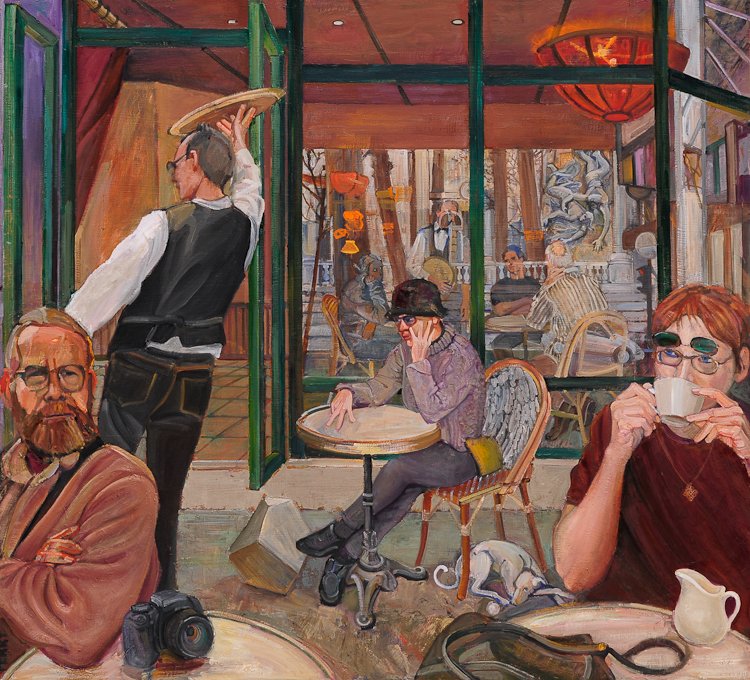 Café Melancolie, oil on canvas, 35 x 39 inches, copyright ©2009
Café Melancolie, oil on canvas, 35 x 39 inches, copyright ©2009
(myself & friends Tyler and Mary Jane)
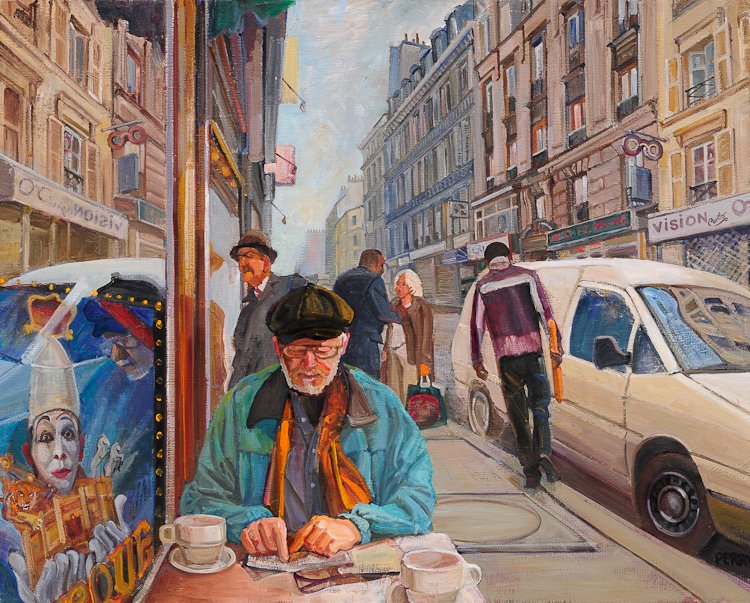 Belleville Cirque, oil on canvas, 24 x 30 inches, copyright ©2009
Belleville Cirque, oil on canvas, 24 x 30 inches, copyright ©2009
(John & Stewart)
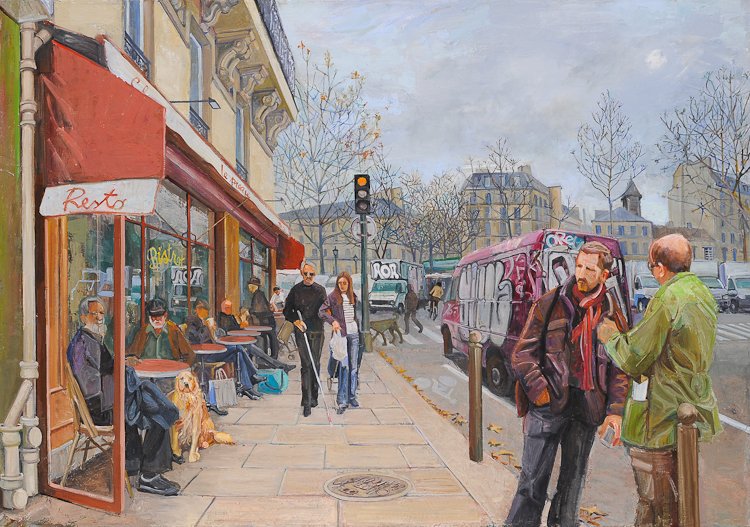 Cafe Resto Preaux, oil on canvas, 32 x 46 inches, copyright ©2011
Cafe Resto Preaux, oil on canvas, 32 x 46 inches, copyright ©2011
(John & Gil)
But those nagging nativist feelings? Paris will never be home. Should I click my heels and return someplace? To Indiana? Or at least to the US? If I were to paint “my people” in “my place,” would I be on more convincing ground? In 2011 I was ready to look around me again. I rolled up eight pieces of clean canvas, carried them to Paris and covered them with paint, keeping Seattle (or the US West) in mind, painting largely from photos taken on walks in Seattle’s Central District, where we live. These are still under construction. Previews by local fans are not necessarily encouraging. (“So desolate!”)
At the same time, I have decided that I need to close a circle, to complete at least three of the large India paintings begun in 2004 on what was clearly our final visit there, large presences on the studio walls, demanding works emitting reproaches for my neglect these seven years. In particular I want to take on “Inside the Bubble” or “The Gods Are Often Blue,” a painting begun in the wake of the Iraq War.
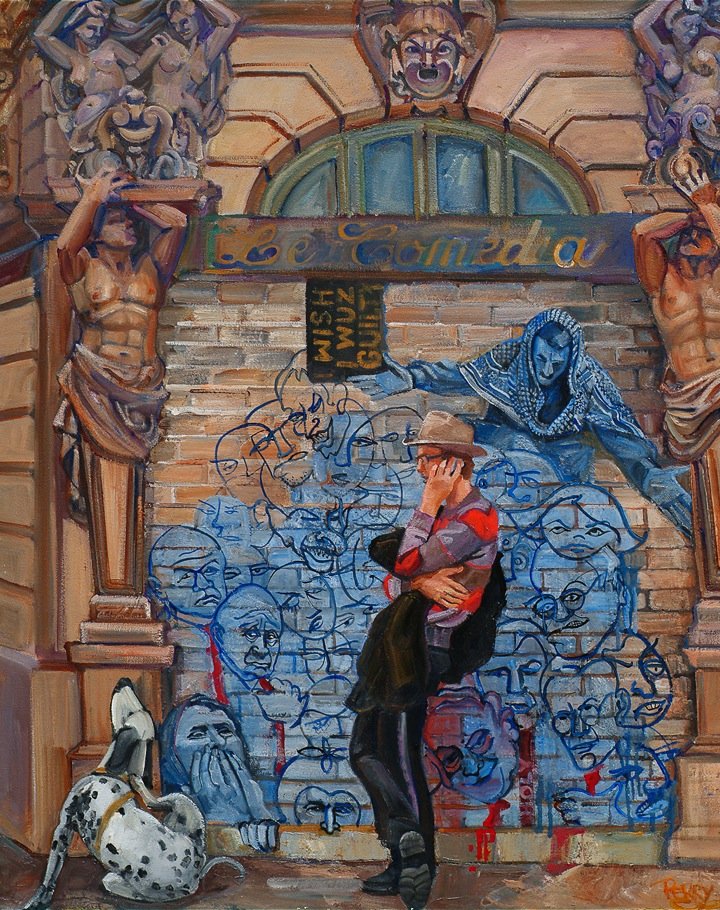 Newshounds Have Fleas, oil on canvas, 30 x 24 inches, copyright 2004
Newshounds Have Fleas, oil on canvas, 30 x 24 inches, copyright 2004
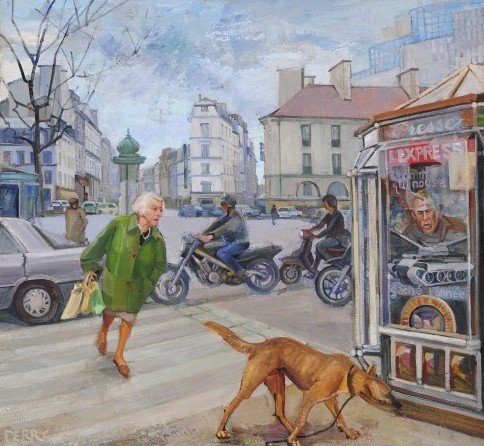 Green Lady Crossing, oil on canvas, 28 x 30 inches, copyright 2003
Green Lady Crossing, oil on canvas, 28 x 30 inches, copyright 2003
Art is political . Whether it invokes magical, perhaps animistic, powers on the walls of caves or celebrates the color purple on cloth, painting has always had strong ties to authority and its structures. One way or another, whether s/he represents thundering herds of animals, the consequences of virgin birth, Phillip IV, paint chips, or the existence of vision itself, the painter is dealing with value or its (supposed) absence, making use of global resources on behalf of one force or another. Reduced to its grubbiest, the painter’s task is promoting patronage. Pushed to its most transcendent, it can seem to embody life itself. But it is fair to say that some art is more overtly political than other art. Overt political painting is risky: there is danger of becoming a hack propagandist, or, worse, the richest painter in the history of art. (See Hirst, Damien.) Pushed by simmering anger, I have tried gently political paintingsor even completely political ones (Newshounds). But “Bubble/Blue Gods” is big, so big that moving it down from the studio will be a problem. Surely its mission is oversized. However, as a recapitulation of “You With the Evil Eye/Marigolds,” (1990) it is for me an important marker in the twenty-year trajectory. Unlike the original Marigolds “Evil Eye,” a painting with relatively benign content (an overt message that invokes Gandhi rather than, say, some nameless American president), I want it to question American corporate imperialism. This undertaking is especially ambitious since I need to produce enough simultaneous aesthetic merit to lift it beyond tedious invective that would undermine its claim to wall space. At this point its surface has become significantly dense, reflecting growing willingness to accept Bill Elston’s advice to spare no paint as well as the continuing influence of Lucian Freud, a painter who uses the medium to hold together his searching, worldly pictures.
Below, “Inside the Bubble” or “Sometimes the Gods Are Blue,” in its April 2012 state:
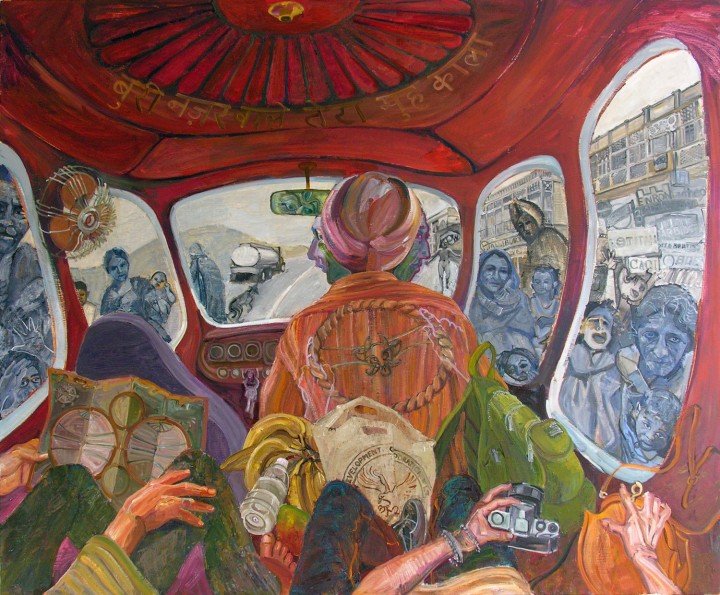 Bubble: Evil Eye II, oil on canvas, 50 x 60 inches, copyright 2012
Bubble: Evil Eye II, oil on canvas, 50 x 60 inches, copyright 2012
Watch these posts for evidence of Bubble’s final coat of paint, sometime, I hope, before fall 2012. Expect as well some prose about its iconography and a change in my world view causing the current Hindi inscription to retreat from the “You with the evil eye may you also be blessed” which seemed appropriate for the 1990 Marigold painting to Bubble’s “You with the evil eye may your face be covered with soot.”
For closers: in recognition of International Labor Day, inaugural date for this site: Trimmer 2011-2012. Out she goes, artwork on the job–despite the call for a General Strike!
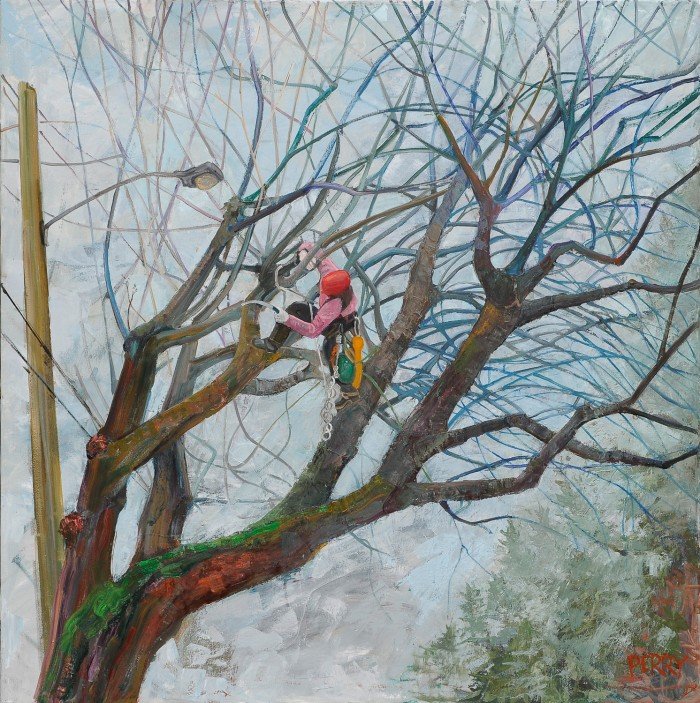 Trimming, oil on canvas, 34 x 34 inches, copyright ©2012
Trimming, oil on canvas, 34 x 34 inches, copyright ©2012
The following comments were posted to an older version of this blog:
14 Responses to “RETRO/proSPECTIVE: TWENTY SOME YEARS PAINTING IN SEATTLE”
Sean says:
May 1, 2012 at 3:48 am
Great stuff Sue! So glad to have this resource :-)
Richard Wells says:
May 1, 2012 at 3:37 pm
Just a cursory view thus far, but I’m quite taken by your work. Thanks for sharing it. Please let me know of any actual exhibitions.
Rob Stitt says:
May 1, 2012 at 5:56 pm
Wonderful show. I’ll be back to see some more!
William Elston says:
May 1, 2012 at 6:01 pm
Great work, Sue! I think the site looks pretty good too.
Susan Wagner says:
May 1, 2012 at 9:02 pm
Congratulations Sue!
It’s wonderful seeing the compilation of your work over the years. I know it took a lot of doing but was well worth the time and energy.
Susan and Ken
Deborah Raptopoulos says:
May 1, 2012 at 10:30 pm
Dear Sue,
This is a brilliant collection of your work that allows us all to be nourished in our mind
and through our senses. You excite, expand, and enrich us with your political and
personal narrative portrayed in your images. You let us know how complicated and multi-layered
life is. Bravo, Sue. These paintings are nothing short of extraordinary, just like you.
Debbie
Celia says:
May 1, 2012 at 11:47 pm
It’s just fantastic, what you have put together so beautifully- your entire body of work. I so enjoyed spending time with some of my favorite “friends” and exploring more recent works. You should be quite proud. I am.
Lynne says:
May 2, 2012 at 7:06 pm
Sue, Absolutely beautiful website. It showcases you work well. I have ‘turned on’ several of the slide shows and enjoyed them flowing across my screen as I grade papers at work. Very restful! I’m so pleased that you have a venue to show your paintings, which I have long admired.
Philippe says:
May 3, 2012 at 5:14 am
Bravo Sue. Très jolie rétrospective de tes oeuvres. On en aimerait encore plus. Je suivrai tout ça grâce à ton site !
Catherine Maubourguet says:
May 3, 2012 at 8:43 pm
What a hudge “bonheur” to discover so many paintings that i didn’t know; to be able to see them all; to chose a subject and come back to another one… very exciting, and the text which I read partly seems to express your diversity and rich sensitivity.
Thank you for this pleasure you’re offering us
Geoff says:
May 29, 2012 at 2:07 am
[Re title to 1st Seattle studio painting: The Gods Prefer Marigolds, You With the Evil Eye, 1990 {As explained in the biographical note, the Devanagari script in the left corner is a blessing quoted from an inscription on the back of one of the 3-wheeler autorickshaws]: “You With the evil eye may you also be blessed.”)]
You with the luciferian eye, soon approaching a rare transit, are you in retrogade, transiting towards the morning sky, or is’t tother way about, it’s hard to keep track of these things.
Luciferian:
1 — used as a name of the devil
2 : the planet Venus when appearing as the morning star
3 not capitalized : a friction match having as active substances antimony sulfide and potassium chlorate
–Lu£ci£fe£ri£an adjective
Valerie Trueblood says:
May 30, 2012 at 7:59 pm
Where else do we see paintings like this?
For a long time, photography seemed to have appropriated the image, the seen moment itself. I think this unique body of work returns it to painting, and goes further–a kind of third step in art. These people–some hurrying, others stalled or exhausted–appear at first to be figures from daily urban life. But there’s a weight of strangeness in them, there’s misgiving, and the shadow of lives that went on in these places before. The intensity is often beyond the apparent subject, and so is the occasional peace, though this is an artist who can and does paint the shocking too.
These paintings are a system of representing the world, full of signs and repetitions to guide us. All those reflections! On the subway, people’s reflections in the windows look in from another world.
Characters from books, sculpture and paintings appear in restaurants, beside graves: the range of reference is huge. SP resists the term narrative. What about poem? The paintings may not be “about” human acts and effort but they’re moving in the way a poem is, while of course having the greater directness, the unspokenness of paint.
I can’t think of anything like them, the way they grapple with time, suffering and aloneness, while at the same time showing us as such a restless, entangled tribe. Not to even touch on the figures themselves–that blond woman on the Metro! the buildings, the vehicles! The graffiti, the dogs, the trees. Bravo.
Geoff says:
June 2, 2012 at 8:21 pm
You placed a dog between two men,
Where before a woman with an apple sat,
It helped the inadequate canvass
Support the rolling girl.
The space cleared around it,
And welcomed it in.
Instead of the deceiving Eve, a dog,
With a ball played on the Pont des Arts.
It took dominion over care,
The dog was with fur in place of hair.
It did not forgive the cycling girl,
Nor blame her for the forsaken world.
SuePerry says:
June 2, 2012 at 10:33 pm
I love the Stevensian pome, espesh the last quatrain. Very apropos, without being questionable about Eves these days. JOP





















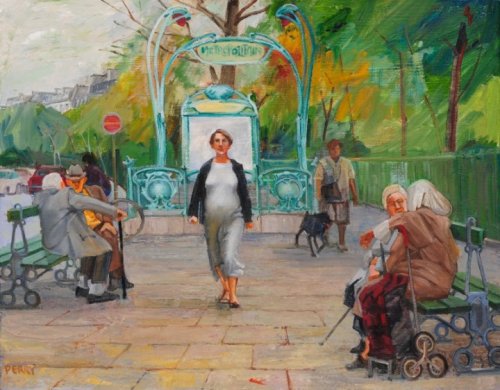
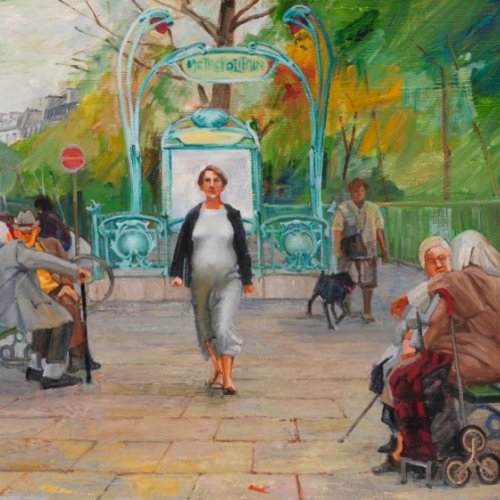

 suzumebachi design
suzumebachi design